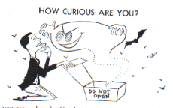 |
 |

playhaus@panicresearch.com |
|
 |
 |
 |
Mummies of the Insaneby David Craig |
|
| Besides winding roads and cool shacks to look at, West Virginia has
its share of offbeat attractions. On the web, Ronna discovered a site devoted
to roadside attractions that mentioned "The Mummies of the Insane," housed
in a renovated bathroom--now mummy shrine--in a historical museum in the
town of Phillipi.
We burst into the Barbour County Historical Museum and asked, "Where are the mummies?" "Mummies? You have mummies?" Olivia Sue Lambert, the volunteer hostess working the front desk said in surprise. "You always have people who say, 'Where are the Daddies?' They're downstream. They washed down the river in the flood," she said, referring to the three male mummies that washed out of the museum in the Flood of 1985. She tells us that 90 percent of visitors don't even know about the mummies; they come to see historical artifacts. But we'd take mummies over history any day, especially insane mummies. We pay a dollar each to Olivia Sue and are lead to the former bathroom where the mummies lie in glass encased boxes. Nothing distracts us--not even such relics as razors used in Forman's Barber Shop--as we make our way to the back of the museum. Left alone to commune with the mummies, Ronna notes their wood-like
appearance and I notice the fake flowers strewn across their sunken chests.
The bodies are brown with age and seem hollow. Their fingers are as gnarled
as their ears are shriveled. Spying a new air freshener gracing each box
makes me realize that mummy feet are not for faint-of-heart foot fetishists.
|
Newspaper articles taped to the tile walls tell the story of these
two unclaimed bodies from the West Virginia Hospital for the Insane, which
were given to a local man who wanted to demonstrate an embalming recipe
he discovered in the Bible. The recipe consisted of water, saltpeter, and
absorbable fumes that arise from the combustion of sublimed sulfur. In
the late 1800s, the mummies toured Europe with P.T. Barnum.
Mummy owner "Bigfoot" Byer donated the mummies to the museum and now a quarter of the $3-4,000 dollars collected each year goes to a football scholarship. Bigfoot's brother was a football coach. Avanelle W. Myers, who started the museum, refused to let the mummies in, but they were on display a week after she died. "The children always want to see them," Olivia Sue points out. "Of course, the kids don't have any money. They've been up to McDonald's and they've spent all their money for hamburgers. I should let them see them for nothing, but that really isn't fair." As we leave, Olivia Sue calls out to an unsuspecting visitor, "Did you
see the still? You can't leave without seeing the still." Off she goes
to explain the history of yet another can't-miss West Virginia attraction.
[This article originally appeared in MOLE #13]
|
 |
 |

playhaus@panicresearch.com |
|
 |
 |
 |